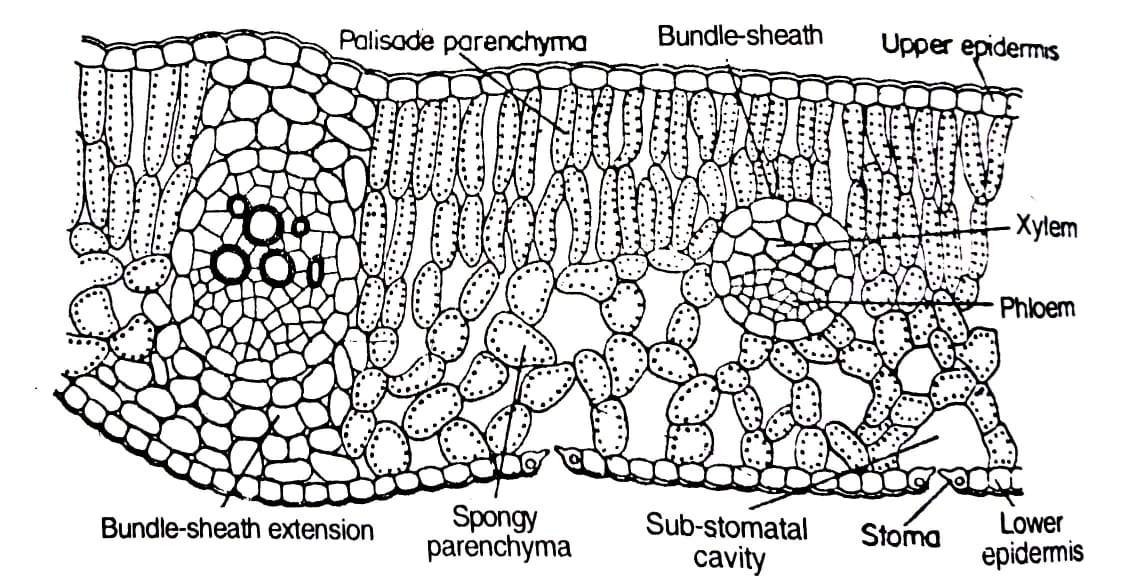Virtual experiments to study characteristics of plant cells and genomes
Theory
Microscopic study of leaf cells is a fundamental component of plant biology education. It provides students with hands-on experience in observing biological structures and processes, fostering a deeper appreciation and understanding of plant anatomy and physiology. Anatomy on leaf cells under the microscope can have practical applications in agriculture, forestry, and environmental science. For example, understanding how different plant species or cultivars respond to environmental stress can inform crop breeding and management strategies.
Leaf cells are diverse and specialized to perform various functions essential for plant growth, development, and survival. Plant leaf cells are crucial for photosynthesis, gas exchange, water regulation, protection, structural integrity, nutrient storage, production of metabolites, environmental interaction. Their functions assist in the growth, survival, and reproduction of plants. Another unique aspect of leaves is that they support the ecological chain and form an important part of consumption. Leafy vegetable are an important source of nutrition.
Some facts about leaf cells:
Spinach is rich in vitamins A, C, K, and folate. It also provides minerals like iron, calcium, and magnesium. Spinach is known for its antioxidant properties due to high levels of lutein and zeaxanthin, which promote eye health and reduce the risk of chronic diseases.
Cacti have adapted to arid environments by transforming their leaves into spines, which serve to conserve water and protect the plant. The photosynthetic function has shifted to the thick, fleshy stems, which also store water. These modifications enable cacti to thrive in harsh, dry climates where water conservation is critical.
Vasicine is a vital alkaloid found in the leaves of Adhatoda vasica, with significant therapeutic benefits, especially for respiratory health. Its bronchodilator and expectorant properties make it particularly effective in treating conditions like asthma, bronchitis, and persistent cough.
The common types of cells in a leaf are as follows:
Epidermal Cells:
Upper Epidermis: These cells form the outermost layer of the leaf and are often transparent to allow light penetration. The upper epidermis in plant leaves typically consists of a single layer of parenchyma cells.
The cuticle is a waxy covering that covers the upper epidermal cells. This layer, which acts as a barrier against pathogen invasion and water loss, is mostly made up of waxes and cutin.
Lower Epidermis: It is similar to the upper epidermis, but may contain specialized structures like stomata and trichomes.
Stomatal Guard Cells
These paired cells surround the stomatal pore and regulate gas exchange, controlling the influx and efflux of gases such as oxygen, carbon dioxide, and water vapour.
The stomata guard cells in C3 and C4 plants, while similar in basic structure, are organized differently to optimize their respective photosynthetic processes and adapt to their environments. C3 plants, such as wheat and rice, generally have more stomata on the leaf underside to reduce water loss, while C4 plants, such as maize and sugarcane, have a more even distribution of stomata to maximize efficiency in harsher environmental conditions.
Palisade Mesophyll Cells:
These are located in the upper layer of the leaf and contain numerous chloroplasts. They are responsible for most of the photosynthesis in the leaf.
Spongy Mesophyll Cells:
These are found beneath the palisade mesophyll. These cells are more loosely packed and facilitate gas exchange, allowing for the diffusion of gases between the leaf's interior and the surrounding environment.
While the spongy mesophyll layer is a common feature in most plants, specific adaptations in plants like the water lily highlight its role in buoyancy and gas exchange in aquatic environments. Similarly, xerophytes (Opuntia spp.) and halophytic plants (Atriplex spp.) In xerophytic plants like cacti, the spongy mesophyll is often reduced or modified to conserve water. The cells may have thicker walls and smaller intercellular spaces to minimize water loss, an adaptation to arid environments. In halophytic plants, the spongy mesophyll may contain salt glands or structures to store excess salt. This adaptation helps the plant survive in saline environments by sequestering salt away from the photosynthetic machinery.
Trichomes:
These are hair-like structures that protrude from the epidermis and can serve various functions such as reducing water loss, providing protection against herbivores, and reflecting excess sunlight.
Vascular Cells:
Xylem: It transfers nutrients and water from the soil that the roots have taken up to the remaining parts of the plant, including the leaves.
Phloem: It transports organic molecules, including sugars, from the leaves to other sections of the plant.
Guard Cells:
To control the opening and closing of specialized pores, such as those found in hydathodes, additional guard cells may be present in certain leaf structures in addition to the specialized guard cells that surround stomata.
Accessory Cells:
These cells support the function of other leaf cells and structures. They may include cells associated with vascular bundles, such as bundle sheath cells, which surround veins and provide support and protection.
e.g., In maize (Zea mays), a C4 plant, bundle sheath cells play a critical role in concentrating CO2 around the enzyme Rubisco, thereby increasing photosynthetic efficiency.

Fig. Transverse section of a dicot leaf
These are just a few examples of the diverse types of cells found in leaves. Each type plays a unique role in the overall function and physiology of the leaf, contributing to processes such as photosynthesis, gas exchange, water regulation, and defence against environmental stresses.
